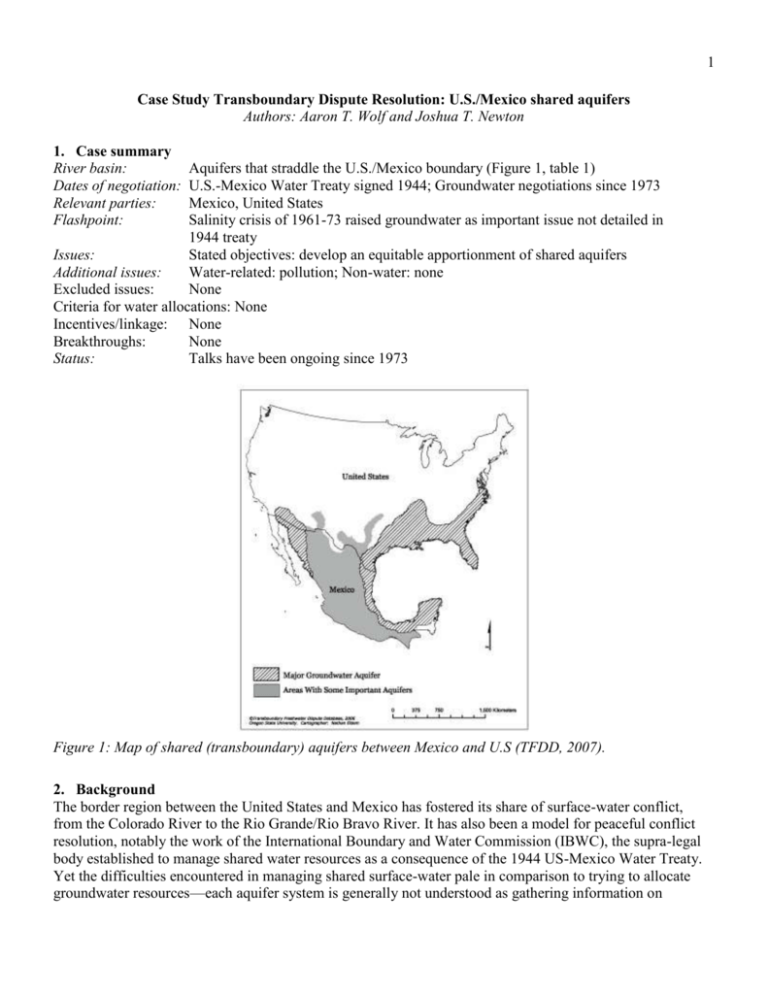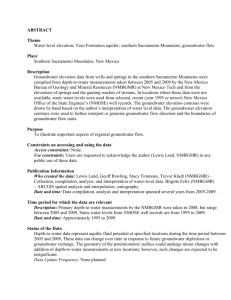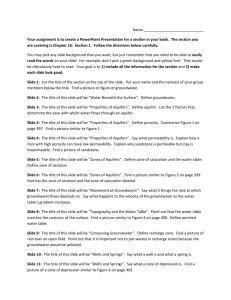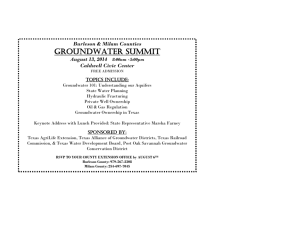US-Mexico aquifers - Transboundary Freshwater Dispute Database
advertisement

1 Case Study Transboundary Dispute Resolution: U.S./Mexico shared aquifers Authors: Aaron T. Wolf and Joshua T. Newton 1. Case summary River basin: Dates of negotiation: Relevant parties: Flashpoint: Aquifers that straddle the U.S./Mexico boundary (Figure 1, table 1) U.S.-Mexico Water Treaty signed 1944; Groundwater negotiations since 1973 Mexico, United States Salinity crisis of 1961-73 raised groundwater as important issue not detailed in 1944 treaty Issues: Stated objectives: develop an equitable apportionment of shared aquifers Additional issues: Water-related: pollution; Non-water: none Excluded issues: None Criteria for water allocations: None Incentives/linkage: None Breakthroughs: None Status: Talks have been ongoing since 1973 Figure 1: Map of shared (transboundary) aquifers between Mexico and U.S (TFDD, 2007). 2. Background The border region between the United States and Mexico has fostered its share of surface-water conflict, from the Colorado River to the Rio Grande/Rio Bravo River. It has also been a model for peaceful conflict resolution, notably the work of the International Boundary and Water Commission (IBWC), the supra-legal body established to manage shared water resources as a consequence of the 1944 US-Mexico Water Treaty. Yet the difficulties encountered in managing shared surface-water pale in comparison to trying to allocate groundwater resources—each aquifer system is generally not understood as gathering information on 2 Table 1: Features of the US/Mexico shared aquifers. Watershed features a Name Riparian states Riparian relations (with dates of Average (With % of national available most recent agreements) annual flow water being utilized) ba Size (km2) Climate Special features n/a Dry Groundwater not included (km3/yr.) C U.S.-Mexico Mexico (22.3), United States Warm (1944 Water Treaty, modified n/a Aquifers (21.7) in 1979) (Ground Water) a Values for lakes under "Annual Flow" are for storage volumes. b Source: Kulshreshtha (1993) created in January 1993. c Sources: Gleick ed. (1993); UN Register of International Rivers (1978). Remaining data from TFDD, 2007. in original treaty, leading to uncertainty in relations 3 aquifers is very costly and the science of groundwater is still inexact. This makes negotiations over a shared aquifer system very difficult. Mumme (1988) has identified 23 sites in contention in six different hydrogeologic regions along the 3,300 kilometers of shared boundary. While the 1944 Treaty mentions the importance of resolving the allocations of groundwater between the two states, it does not do so. In fact, shared surface-water resources were the focus of the IBWC until the early 1960s, when a U.S. irrigation district began draining saline groundwater into the Colorado River and deducting the quantity of saline water from Mexico's share of freshwater. In response, Mexico began a "crash program" of groundwater development in the border region, to make up the losses. 3. The problem The complications of groundwater are exemplified in the border region between the United States and Mexico where, despite the presence of an active supra-legal authority since 1944, groundwater issues have yet to be resolved. Mentioned as vital in the 1944 Treaty, and again in 1973, the difficulties in quantifying the ambiguities inherent in groundwater regimes has eluded legal and management experts ever since. 4. Attempts at conflict management Ten years of negotiations resulted in a 1973 addendum to the 1944 Treaty—Minute 242 of the IBWC, which limited groundwater withdrawals on both sides of the border, and committed each nation to consult the other regarding any future groundwater development. In all of the Minutes added to the 1944 Treaty since its inception, Minute 242 is still the only agreement between the two nations with regards to groundwater pumping. Mumme (2004) states that there are three main reasons why Minute 242 has had trouble being advanced as its agreement intended. First, and maybe most importantly, was that there was not the political support to carry out Minute 242. A rift between state and federal government over whose authority it was to control water rights played a key role and when there are 96 seats in the House of Representatives from the border region, this makes it difficult to pass any legislation going against thosestates. Secondly, it is possible that Minute 242 did not refer to groundwater quality in general, but more pointedly at salinity. This may have averted governments from pursuing appropriate studies. And third, the terms of reference of both Minute 242 and the 1944 Treaty are not very clear. The wording of the agreements does not have enough definition to promote decisive acts and leaves much to be questioned. 5. Outcome Even after three decades of having problems with Minute 242 and groundwater issues, there does not appear to be a movement towards a new agreement referring to the United States-Mexican shared aquifers anytime soon, although Mumme (2004) states that it is likely that “some form of systematic cooperation will emerge” between stakeholders in more local areas along the border. 6. Lessons learned Even if conditions for agreement are good, this does not guarantee that issues will be resolved. It is testimony to the complexity of international groundwater regimes that despite the presence of an active authority for cooperative management, and despite relatively warm political relations and few riparians, negotiations have continued since 1973 without resolution. Difference of opinion of federal and state governments can impede cooperation. 4 After Minute 242 was agreed upon by both Mexico and the United States, the differences between the United States federal government and the government of the States bordering Mexico most likely played a role in the lack of cooperation between the two nations with regards to groundwater resources. 7. Creative outcomes resulting from resolution process Treaty includes mechanism to modify terms and even topics covered, essentially allowing for adaptive management, without renegotiating entire treaty. 8. Timeline 1944 US-Mexico Water Treaty signed. IBWC expanded to include water allocation within its responsibilities. 1973 Minute 242 on groundwater signed between Mexico and the United States. 1983 La Paz Agreement signed creating technical working groups that addressed water quality among other environmental concerns. 1993 North American Free Trade Agreement (NAFTA) signed. 1994 NAFTA implemented. 5 References Gleick, P.H., ed. Water in Crisis. A Guide to the World’s Fresh Water Resources, New York: Oxford University Press, pp. 13–24. Kulshreshtha, S.N. (1993). World Water Resources and Regional Vulnerability: Impact of Future Changes. RR-93-10, IIASA, Laxenburg, Austria. Mumme, S. 1988. “Apportioning Groundwater Beneath the U.S.- Mexico Border: Obstacles and Alternatives.” Center for U.S.- Mexican Studies Report Series 45. Mumme, S. (2004). Advancing binational cooperation in the transboundary aquifer management on the U.S.-Mexico Border. Paper presented at Groundwater in the West Conference, University of Colorado at Boulder. Transboundary Freshwater Dispute Database (TFDD) (2007). Oregon State University. Available on-line at: http://www.transboundarywaters.orst.edu/ United Nations. (1978). Register of international rivers, Water Supply Management, 2 (1). New York: Pergamon Press.








